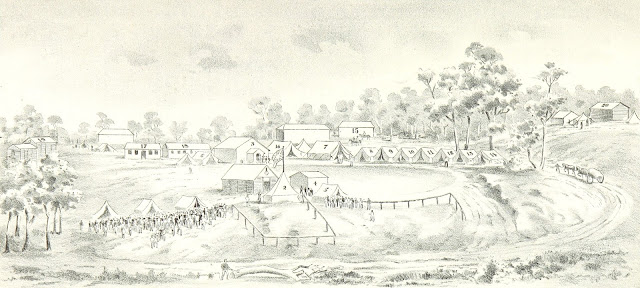Title: Bendigo Government Camp 1853 - Reproduced from Sketch Supplied by J. A. Panton, Resident Commissioner
KEY TO SKETCH.
1. Gold Office
2. Guard Room Tent
3. Officers' Mess Tent
4. South Australian Commissioner's House
5. South Australia Gold Office
6. Sub-Inspector of Police
7. Resident Commissioner's (Panton's) Tent
8. Assistant Commissioner Cockburn
9. Assistant Commissioner Barnard
10. Escort Office
11. Assistant Commissioner McKenzie
12. Assistant Commissioner Murray
13. Officer Commanding Detachment 40th Regiment
14. Gold-Commissioner Jones
15. Officers' Stables
16. Inspector of Police
17. and 18. Police Barracks
19. Military Barracks
20. Lockup on Gaol Hill
LIST AND PARTICULARS OF SOME OF THE GOVERNMENT OFFICERS WHO WERE STATIONED ON BENDIGO GOVERNMENT CAMPS IN THE FIFTIES, KINDLY SUPPLIED BY J. A. PANTON, C.M.G.
Assistant Commissioners
Captain Dane, in 1851 and early 1852, never in main camp (dead)
J. Clough, 1852 (dead)
G. E. Gilbert, 1852 (retired)
J. A. Panton
Ousley Cockburn, 1852 and 1853 (retired)
C. Shuter, 1852 (late P.M., Melbourne)
C. Dowling, 1853-54, afterwards Creswick (dead)
McKenzie (dead)
Rudolph Reid, R.N. 1852 (dead)
Captain John Urquhart, 1853-54, afterwards Paymaster 21st Regiment
Willoughby (dead)
Crawford Mollison, afterwards Resident Warden and P.M. (dead)
E. T. Barnard, afterwards Resident Warden, Beechworth
Fred Standish (and Chinese Protector), afterwards Chief Commissioner of Police
Captain Burnet (retired and returned to England)
Captain Virginius Murray, father of Government Geologist.
Police Magistrates
Captain Stewart
L. MacLachlan
T. Foster, afterwards Superintendent of Police
Police Superintendents
David Armstrong
T. Lyttleton
Inspectors
F. Winch, afterwards Superintendent, Melbourne (dead)
Captain Flemming (dead)
Captain Evans, afterwards Ballarat
J. Pearman, afterwards Melbourne
H. M. Chomley, now Chief Commissioner of Police
W. Templeton, afterwards Warden and P.M. (dead)
Lieutenants
Kabat, afterwards Superintendent of Police (dead)
Kossack (retired)
Brook Smith, afterwards Inspector (dead)
Commissariat Officer in charge
J. Lapsley
Medical Officer
J. McCrae
M. D. Dublin (retired, dead)
Postmaster
Watts
Camp Surveyor
J. Smith
Commanding Detachment 40th Regiment
Captain O'Hara
Commanding Pensioners
Lieutenant Finch, 11th Regiment
Clerk of Courts
Mr. Saunders
Chief Clerk to Resident
Mr. Skene
Gold Receivers
Mr. Wilkinson
Frank Jones, afterwards Commissioner of Audit
Government Surveyor
Mr. Larritt
South Australian Commissioner, appointed to receive Gold, &c., for S.A. Overland Escort
Reynell, and
Hutton (his clerk)
Also Johns, now P.M. at Hamilton
Provenance: "Bendigo and Vicinity." A Comprehensive History of Her Past, and a Résumé of Her Resources; Together with the Biographies of Her Representative Pioneers, Public, Commercial, and Professional men. Compiled by W. B. Kimberley, in collaboration with J. J. Pascoe. With plates.
Author: W. B. Kimerley
Contributor: J. J. Pascoe
Date of Publication: 1895
Publisher: F. W. Niven & Co.
Place of Publishing: Melbourne & Ballarat
Copyright status: This work is out of copyright
Courtesy: The British Library








This newspaper article has some more details about some of the officers. For example Captain Dane resigned after 6 or 7 weeks because "of the utter want of system and organisation on the part of the authorities in Melbourne." BENDIGO SINCE '51 (1888, September 29). Bendigo Advertiser (Vic. : 1855 - 1918), p. 3. Retrieved September 6, 2017, from http://nla.gov.au/nla.news-article88554936
ReplyDeleteThanks for the link Anne, it's a very interesting article about Bendigo.
DeleteIs the Government Camp like the administrative area or Government Offices for Bendigo in lieu of their being a town? It would be interesting to know where this "camp" was in relation to the the center or Bendigo or the acutal mining areas.
ReplyDeleteHi Sandra,
DeleteYes the Government Camp was the administration area for Bendigo and where the Commissioner for the gold-fields operated from.
The late Mr. George Edward Thomson, a prominent old resident of Bendigo, suppled this account of the camp in 1895:
"The camp, as it is usually styled, occupied an area of ground of about seventy acres in extent, the boundary lines of which faced a row of stores called Camp Street, on the south-east; Commissioner's Gully, now the Upper Reserve, on the north-west; View Street, then merely a small gully, to the west; and the road passing the Bendigo Hotel to Barnard Street, to the east. The whole was enclosed by a two-railed fence, but the formation of the surface was very different from what it is now. The present fence facing the Mall was about a chain further in towards the rising ground; from thence to the upper walk from the View Street entrance the ground was flat, terminating with an abrupt ledge of rock, a continuation of the same reef still existing near the Court House, running through the wood where the master of the High School now has his residence, and continuing nearly to the western boundary. At the base of the rock was the natural channel of the Bendigo Creek, a small portion of which until quite recently was enclosed within the present fernery. The upper ground was reached by two paths, one at View Street, and the other along the same tracks by which the Court House is at present approached."
Source: Bendigo and Vicinity - page 15; held in the British Library online collection. Link to download book: http://access.bl.uk/item/pdf/lsidyv2b176dcd